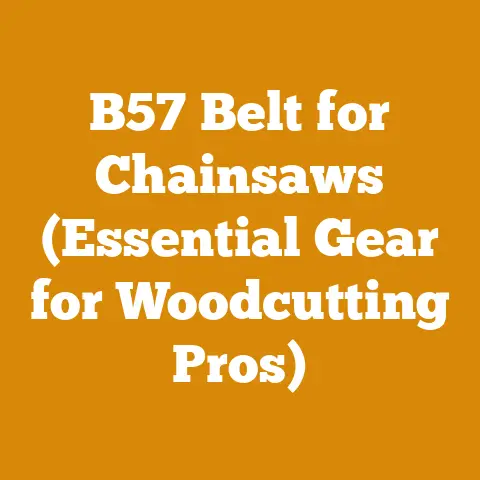Brush Cutter vs Trimmer (5 Pro Tips for Dense Brush)
Brush Cutter vs Trimmer (5 Pro Tips for Dense Brush)
Blending styles, much like choosing the right tool for a job, is essential for success.
When facing dense brush, the line between a simple trimmer and a robust brush cutter blurs.
Both tools serve the purpose of clearing vegetation, but their capabilities and applications differ significantly.
Choosing the right one can dramatically impact the efficiency, cost, and overall success of your land-clearing projects.
Understanding the Terrain: Brush Cutter vs. Trimmer
Before we get into the nitty-gritty, let’s define our terms.
Trimmer (String Trimmer/Weed Eater): Primarily designed for light-duty trimming around lawns, gardens, and walkways.
They use a rotating nylon string to cut grass and weeds.Brush Cutter (Clearing Saw): A heavier-duty tool built to tackle thick brush, saplings, and dense vegetation.
They typically use metal blades instead of nylon strings.
The key difference lies in their power and cutting capacity.
A trimmer is like a scalpel, perfect for precision work on soft targets.
A brush cutter is more like a machete, capable of hacking through tougher obstacles.
Pro Tip #1: Assessing Your Brush Density and Project Scope
The first step in choosing the right tool is to accurately assess the density of the brush you’re dealing with and the scope of your project.
This is where my years of experience in wood processing come into play.
I’ve learned that a hasty decision based on initial impressions can lead to frustration and wasted resources.
Density Assessment:
- Light Brush: Mostly grass, weeds, and thin foliage. A standard trimmer should suffice.
- Medium Brush: Thicker weeds, small shrubs, and saplings up to 1 inch in diameter.
A powerful trimmer or a light-duty brush cutter is recommended. - Dense Brush: Overgrown vegetation, thick shrubs, saplings exceeding 1 inch in diameter, and potentially thorny bushes.
A heavy-duty brush cutter is essential.
Project Scope:
- Small Area (e.g., garden edge): A trimmer might be adequate, even for medium brush, if the area is small and manageable.
- Large Area (e.g., overgrown field): A brush cutter is crucial for efficient clearing, regardless of the brush density.
My Experience: I once underestimated the density of a patch of overgrown blackberries.
I started with a trimmer, thinking I could manage.
After a couple of hours of struggling and constantly replacing the string, I realized I needed a brush cutter.
This cost me valuable time and effort.
Lesson learned: be honest about the challenge ahead.
Pro Tip #2: Evaluating Power Source and Ergonomics
Both trimmers and brush cutters come in various power source options:
- Electric (Corded): Lightweight and environmentally friendly, but limited by the cord’s reach.
Suitable for small areas and light brush. - Electric (Battery-Powered): More portable than corded electric models, but battery life is a key consideration.
Good for medium-sized areas and light to medium brush. - Gas-Powered: The most powerful option, offering cordless operation and extended run time.
Best for large areas and dense brush.
Ergonomics:
Ergonomics play a vital role, especially for extended use. Consider the following:
- Weight: Lighter tools reduce fatigue.
- Handle Design: Look for adjustable handles and comfortable grips.
- Harness/Straps: A harness distributes the weight and reduces strain on your back and arms.
Cost Considerations:
- Electric Corded: Typically the cheapest option upfront, but limited in scope.
Expect to pay between $50 and $150. - Electric Battery-Powered: A good balance of power and portability.
Prices range from $150 to $400, depending on battery voltage and capacity. - Gas-Powered: The most expensive option, but also the most powerful and versatile.
Prices range from $200 to $600 or more.
Data Point: According to a 2023 survey by the Outdoor Power Equipment Institute (OPEI), gas-powered brush cutters are the preferred choice for professional landscapers and forestry workers dealing with dense brush.
My Insight: I’ve used both gas-powered and battery-powered brush cutters.
While the battery-powered models have improved significantly, I still prefer gas for tackling large areas of dense brush.
The consistent power and longer run time make a significant difference.
Pro Tip #3: Selecting the Right Cutting Attachment
The cutting attachment is where the rubber meets the road (or, in this case, where the blade meets the brush).
Trimmers:
- Nylon String: Standard for grass and light weeds.
- Heavy-Duty String: Thicker string for tougher weeds and light brush.
Brush Cutters:
- Metal Blades: Available in various designs, including:
- Straight Blades: Best for cutting grass and weeds.
- Brush Blades: Designed for cutting thick brush and small saplings.
- Saw Blades: Used for cutting larger saplings and small trees.
Blade Selection Guide:
Cost of Cutting Attachments:
- Nylon String: $5 – $20 per spool.
- Metal Blades: $20 – $100 per blade, depending on size and quality.
My Tip: Invest in high-quality blades.
Cheaper blades tend to dull quickly and are more prone to breakage.
I prefer blades made from hardened steel for their durability and sharpness.
Safety Note: Always wear appropriate safety gear, including eye protection, hearing protection, and gloves, when operating a brush cutter.
Kickback from a blade can be dangerous.
Pro Tip #4: Mastering Cutting Techniques for Dense Brush
Even with the right tool, improper cutting techniques can lead to inefficiency and potential injury.
Here are some tips for tackling dense brush:
- Clear the Area: Before starting, remove any large debris, rocks, or hidden obstacles that could damage the blade or cause kickback.
- Work in Sections: Divide the area into manageable sections.
This allows you to focus your efforts and avoid getting overwhelmed. - Use a Swinging Motion: Swing the brush cutter in a wide arc, keeping the blade parallel to the ground.
- Overlap Your Cuts: Overlap each cut slightly to ensure complete coverage.
- Cut from Top to Bottom: When cutting tall brush, start at the top and work your way down.
This prevents the brush from falling on top of you. - Be Aware of Kickback: Kickback occurs when the blade hits a solid object or gets pinched.
Be prepared for it and maintain a firm grip on the tool. - Sharpen Blades Regularly: A sharp blade cuts more efficiently and reduces the risk of kickback.
My Experience: I once tried to clear a dense patch of multiflora rose without properly clearing the area first.
The blade repeatedly hit hidden rocks, causing kickback and dulling the blade.
I learned the hard way that preparation is key.
Cost of Blade Sharpening:
- DIY: Sharpening kits cost between $20 and $50.
- Professional Sharpening: $10 – $20 per blade.
Budgeting Tip: Factor in the cost of blade sharpening or replacement when budgeting for your project.
A dull blade can significantly increase your labor time and fuel consumption.
Pro Tip #5: Budgeting and Cost Management for Brush Clearing Projects
Clearing dense brush can be a costly endeavor.
Understanding the various cost components and implementing effective budget management strategies is crucial for success.
Cost Components:
- Tool Purchase or Rental: As discussed earlier, the cost of a brush cutter ranges from $200 to $600 or more.
Rental options are available for those who only need the tool for a short period.
Rental rates typically range from $50 to $100 per day. - Fuel/Electricity: Gas-powered brush cutters require fuel, while electric models consume electricity.
The cost will vary depending on the size of the area and the density of the brush. - Cutting Attachments: Factor in the cost of replacement strings or blades.
- Safety Gear: Eye protection, hearing protection, gloves, and sturdy boots are essential.
Budget $50 – $100 for safety gear. - Labor: If you’re hiring someone to do the work, labor costs will be a significant factor.
Labor rates vary depending on location and experience, but expect to pay between $20 and $50 per hour. - Disposal: Consider the cost of disposing of the cleared brush.
You may need to rent a chipper or pay for hauling services. - Permits: In some areas, permits may be required for clearing vegetation.
Check with your local authorities.
Case Study: Firewood Preparation Budget
Let’s consider a case study of a small-scale firewood preparation project involving clearing dense underbrush to access fallen trees.
Scenario: Clearing a 1-acre area of dense brush to harvest fallen oak trees for firewood.
Cost Breakdown:
| Item | Estimated Cost | Notes |
| Brush Cutter Rental | $75/day | Assuming a rental of a gas-powered brush cutter for 1 day.
is that you?
| Item | Estimated Cost | Notes






